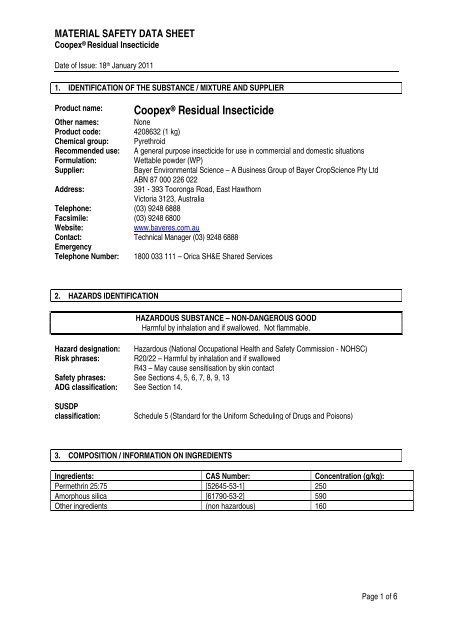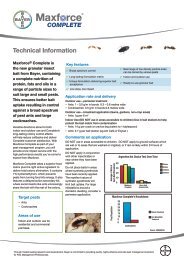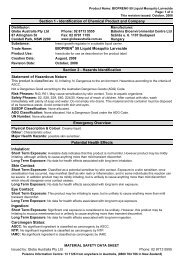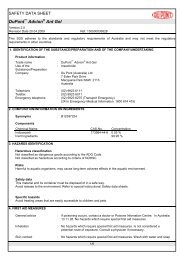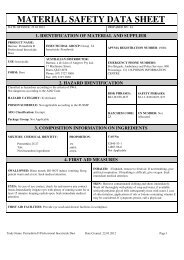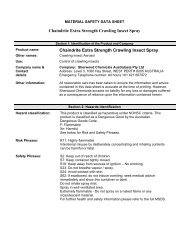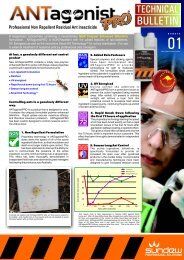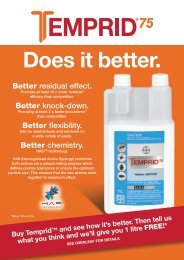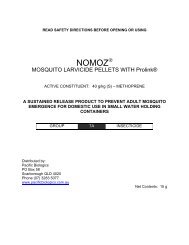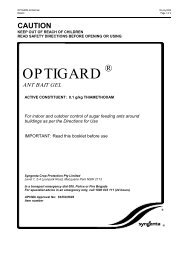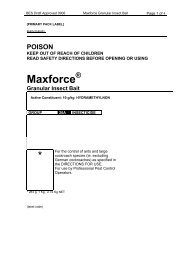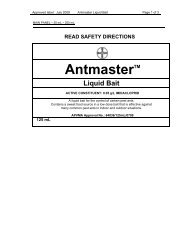Coopex MSDS - Globe Australia
Coopex MSDS - Globe Australia
Coopex MSDS - Globe Australia
You also want an ePaper? Increase the reach of your titles
YUMPU automatically turns print PDFs into web optimized ePapers that Google loves.
MATERIAL SAFETY DATA SHEET<br />
<strong>Coopex</strong> ® Residual Insecticide<br />
Date of Issue: 18 th January 2011<br />
1. IDENTIFICATION OF THE SUBSTANCE / MIXTURE AND SUPPLIER<br />
Product name:<br />
<strong>Coopex</strong> ® Residual Insecticide<br />
Other names: None<br />
Product code: 4208632 (1 kg)<br />
Chemical group: Pyrethroid<br />
Recommended use: A general purpose insecticide for use in commercial and domestic situations<br />
Formulation: Wettable powder (WP)<br />
Supplier:<br />
Bayer Environmental Science – A Business Group of Bayer CropScience Pty Ltd<br />
ABN 87 000 226 022<br />
Address:<br />
391 - 393 Tooronga Road, East Hawthorn<br />
Victoria 3123, <strong>Australia</strong><br />
Telephone: (03) 9248 6888<br />
Facsimile: (03) 9248 6800<br />
Website:<br />
www.bayeres.com.au<br />
Contact: Technical Manager (03) 9248 6888<br />
Emergency<br />
Telephone Number: 1800 033 111 – Orica SH&E Shared Services<br />
2. HAZARDS IDENTIFICATION<br />
Hazard designation:<br />
Risk phrases:<br />
HAZARDOUS SUBSTANCE – NON-DANGEROUS GOOD<br />
Harmful by inhalation and if swallowed. Not flammable.<br />
Hazardous (National Occupational Health and Safety Commission - NOHSC)<br />
R20/22 – Harmful by inhalation and if swallowed<br />
R43 – May cause sensitisation by skin contact<br />
Safety phrases: See Sections 4, 5, 6, 7, 8, 9, 13<br />
ADG classification: See Section 14.<br />
SUSDP<br />
classification:<br />
Schedule 5 (Standard for the Uniform Scheduling of Drugs and Poisons)<br />
3. COMPOSITION / INFORMATION ON INGREDIENTS<br />
Ingredients: CAS Number: Concentration (g/kg):<br />
Permethrin 25:75 [52645-53-1] 250<br />
Amorphous silica [61790-53-2] 590<br />
Other ingredients (non hazardous) 160<br />
Page 1 of 6
MATERIAL SAFETY DATA SHEET<br />
<strong>Coopex</strong> ® Residual Insecticide<br />
Date of Issue: 18 th January 2011<br />
4. FIRST AID MEASURES<br />
If poisoning occurs, immediately contact a doctor or Poisons Information Centre (telephone 13 11 26), and<br />
follow the advice given. Show this Material Safety Data Sheet to a doctor.<br />
Inhalation:<br />
Skin contact:<br />
Eye contact:<br />
Ingestion:<br />
First Aid Facilities:<br />
Symptoms:<br />
Medical attention:<br />
Remove person to fresh air. Keep at rest. Seek medical advice if exposure has been<br />
more than trivial. Administer artificial respiration if breathing has stopped.<br />
Remove all contaminated clothing and shoes. Wash off skin immediately with soap and<br />
plenty of water. Apply vitamin E cream, toilet milks or local anaesthetic creams to reduce<br />
irritation if it occurs. Seek medical advice if irritation persists. Launder contaminated<br />
clothing before re-use.<br />
Immediately rinse eyes thoroughly, including under eyelids, with running water for at least<br />
15 minutes. Seek immediate medical advice.<br />
Wash out mouth with water. Do not induce vomiting. Keep patient at rest and seek medical<br />
advice.<br />
Provide an eyewash station in the workplace.<br />
Burning sensations on the skin, irritation of the mucous membranes, coughing and<br />
sneezing may be experienced. Following severe intoxication, respiratory effects can<br />
include chest tightness, airway hyperreaction, and pulmonary oedema. Possible<br />
circulatory effects include tachycardia, hypotension, and palpitations. Gastrointestinal<br />
symptoms may include nausea, vomiting, diarrhoea, abdominal pain, and salivation.<br />
Potential Central Nervous System effects are dizziness, blurred vision, headache,<br />
listlessness, anorexia, somnolence/coma, seizures/convulsions, tremor, ataxia, and<br />
muscle fasciculations.<br />
There is no specific antidote. Treat symptoms.<br />
Treatment<br />
Basic aid, decontamination, symptomatic treatment and if necessary administration of<br />
antidote.<br />
Note for physicians<br />
Treat large intakes with gastric lavage, and charcoal administration. Use endotracheal<br />
intubation, and artificial respiration (if necessary). Monitor respiratory and cardiac<br />
functions. Observe electrocardiograph, and check for pulmonary oedema in event of<br />
inhalation. Anticonvulsant therapy with diazepam i.v. No antidote known. Treat symptoms.<br />
Recovery should be spontaneous. Elimination by: dialysis, haemo-perfusion.<br />
Contraindication – adrenergic compounds, atropine. DO NOT confuse with<br />
anticholinesterase compounds. Skin contacted by permethrin must be carefully cleaned<br />
with cleansing milk. Symptoms can be partially alleviated by the application of a vitamin E<br />
or moisturising cream or anaesthetic ointment. For eyes, instil local anaesthetic drops e.g.<br />
1% amethocaine hydrochloride eye drops. Give analgesics as necessary.<br />
Page 2 of 6
MATERIAL SAFETY DATA SHEET<br />
<strong>Coopex</strong> ® Residual Insecticide<br />
Date of Issue: 18 th January 2011<br />
5. FIRE FIGHTING MEASURES<br />
Extinguishing media:<br />
Hazards from<br />
combustion<br />
products:<br />
Precautions for fire<br />
fighters:<br />
Hazchem Code:<br />
Foam, dry chemical or water spray. Do not use a water jet from a fire hose.<br />
In the event of fire, hydrogen chloride, carbon monoxide and carbon dioxide may be<br />
released.<br />
Fire fighters should wear full protective gear, including self-contained breathing apparatus<br />
(AS/NZS 1716), as toxic and irritating decomposition products may be produced in a fire. If<br />
it can be done safely, remove intact containers from the fire. Otherwise, use water spray to<br />
cool them. Bund area to prevent contamination of water sources. Dispose of fire control<br />
extinguishing agent and spillage later in a safe manner. Do not release contaminated<br />
water into the environment.<br />
2Z<br />
6. ACCIDENTAL RELEASE MEASURES<br />
Dealing with spills and disposals may result in the potential for increased personal exposure. Protective clothing and<br />
equipment as described in the PERSONAL PROTECTION section should be worn. Avoid contact with spilled<br />
material or contaminated surfaces. Keep people and animals away. Prevent spill from entering drains, sewers or<br />
any body of water. Avoid creating dust. Sweep up into sealable containers for disposal in accordance with<br />
applicable local, state and federal regulations.<br />
7. HANDLING AND STORAGE<br />
Handling:<br />
Storage:<br />
Keep out of reach of children. Avoid contact with eyes and skin. Do not inhale dust.<br />
Store product in the closed, original container in a cool, well-ventilated area away from<br />
direct sunlight.<br />
8. EXPOSURE CONTROLS / PERSONAL PROTECTION<br />
Exposure standards: Safe Work <strong>Australia</strong> exposure standard for amorphous silica – TWA - 10 mg/m³ -<br />
inspirable fraction.<br />
Exposure standard – Time Weighted Average (TWA) means the average airborne<br />
concentration of a particular substance when calculated over a normal eight-hour working<br />
day, for a five-day working week.<br />
Engineering controls:<br />
Control process conditions to avoid contact. Use local exhaust ventilation.<br />
Personal Protective<br />
Equipment:<br />
Eyes:<br />
Clothing:<br />
Gloves:<br />
Respiratory:<br />
Other:<br />
Avoid contact with the eyes. Wear safety goggles or a face shield when<br />
handling product, preparing and using spray.<br />
Avoid contact with skin. Wear suitable protective clothing. Protective<br />
clothing must be stored separately from private clothing.<br />
Avoid contact with the skin. Wear elbow-length PVC or nitrile gloves.<br />
Do not inhale dust. Wear a disposable respirator to prevent inhalation.<br />
Wash thoroughly after handling. Do not eat, drink or smoke until after<br />
washing. After each day’s use wash gloves, goggles or face shield and<br />
contaminated clothing.<br />
Page 3 of 6
MATERIAL SAFETY DATA SHEET<br />
<strong>Coopex</strong> ® Residual Insecticide<br />
Date of Issue: 18 th January 2011<br />
9. PHYSICAL AND CHEMICAL PROPERTIES<br />
Appearance:<br />
Odour:<br />
Vapour pressure:<br />
Vapour density:<br />
Boiling point:<br />
Freezing/melting<br />
point:<br />
Solubility:<br />
Density:<br />
pH:<br />
Flash Point:<br />
Flammability<br />
(explosive) limits:<br />
Auto-ignition<br />
temperature:<br />
Octanol/water<br />
partition coefficient:<br />
Formulation:<br />
Buff-coloured powder<br />
Mild aromatic odour<br />
Negligible<br />
Not available<br />
Not applicable<br />
Not applicable<br />
Forms a Suspension in water<br />
Not applicable<br />
Not available – not flammable<br />
Not applicable<br />
Not applicable<br />
Not available<br />
Wettable Powder<br />
10. STABILITY AND REACTIVITY<br />
Chemical stability:<br />
Hazardous<br />
polymerisation:<br />
Conditions to avoid:<br />
Incompatible<br />
materials:<br />
Hazardous<br />
decomposition<br />
products:<br />
Stable under normal conditions of use.<br />
None<br />
Avoid iron, alloys, oxidisers, strong acids and halogens.<br />
Not available<br />
In the event of fire, hydrogen chloride, carbon monoxide and carbon dioxide may be<br />
released.<br />
Page 4 of 6
MATERIAL SAFETY DATA SHEET<br />
<strong>Coopex</strong> ® Residual Insecticide<br />
Date of Issue: 18 th January 2011<br />
11. TOXICOLOGICAL INFORMATION<br />
POTENTIAL HEALTH EFFECTS<br />
Inhalation:<br />
Skin contact:<br />
Eye contact:<br />
Ingestion:<br />
Other:<br />
Acute:<br />
Oral toxicity:<br />
Dermal toxicity:<br />
Inhalation toxicity:<br />
Skin irritation:<br />
Eye irritation:<br />
Sensitisation:<br />
Inhalation of powder or spray may produce respiratory irritation.<br />
Mild irritant to the skin. The product or spray should not be allowed to come into contact<br />
with the skin.<br />
Will irritate the eyes. The product or spray should not be allowed to contact the eyes.<br />
Harmful if swallowed.<br />
None<br />
ANIMAL TOXICITY DATA:<br />
LD 50 rat: 1479mg/kg (Permethrin 25:75 in corn oil)<br />
LD 50 rabbit: > 2000 mg/kg (permethrin)<br />
LC 50 rat: > 133 mg/L (Product)<br />
Not irritating – rabbit<br />
Slightly irritating – rabbit<br />
Not sensitising - guinea pig<br />
Chronic:<br />
Permethrin is not mutagenic, teratogenic or carcinogenic.<br />
12. ECOLOGICAL INFORMATION<br />
Fish toxicity:<br />
Daphnia toxicity:<br />
Toxicity to algae:<br />
Bird toxicity:<br />
Bee toxicity:<br />
Other:<br />
Environmental fate,<br />
persistence and<br />
degradation:<br />
Permethrin is toxic to fish and aquatic organisms.<br />
Not available<br />
Not available<br />
Not Available<br />
Permethrin is toxic to bees.<br />
Permethrin is toxic to reptiles.<br />
Permethrin degrades rapidly in soil and water.<br />
Page 5 of 6
MATERIAL SAFETY DATA SHEET<br />
<strong>Coopex</strong> ® Residual Insecticide<br />
Date of Issue: 18 th January 2011<br />
13. DISPOSAL CONSIDERATIONS<br />
Single rinse container before disposal. Add rinsings to spray tank. Do not dispose of undiluted chemicals on site.<br />
Dispose of at a local authority landfill. If no landfill is available, bury the containers below 500 mm in a disposal pit<br />
specifically marked and set up for this purpose, clear of waterways, desirable vegetation and tree roots. Empty<br />
containers and product should not be burnt.<br />
14. TRANSPORT INFORMATION<br />
UN number: UN 3077<br />
Proper shipping ENVIRONMENTALLY HAZARDOUS SUBSTANCE, SOLID, N.O.S (contains permethrin),<br />
name:<br />
Class and<br />
Class 9<br />
Subsidiary Risk:<br />
Packing Group: Packing Group III<br />
Hazchem code: 2Z<br />
Marine Pollutant: Yes<br />
Note for Road and<br />
Rail Transport<br />
According to AU01, Environmentally Hazardous Substances in packagings, IBCs or any<br />
other receptacle not exceeding 500 kg or 500 L are not subject to the ADG Code<br />
15. REGULATORY INFORMATION<br />
Registered according to the Agricultural and Veterinary Chemicals Act 1994<br />
<strong>Australia</strong>n Pesticides and Veterinary Medicines Authority Approval Number: 32843<br />
16. OTHER INFORMATION<br />
Trademark<br />
information:<br />
Preparation<br />
information:<br />
Data sources:<br />
<strong>Coopex</strong> ® is a Registered Trademark of Bayer<br />
Replaces September 2008 edition.<br />
Reason for update: Transport information, exposure standards, Hazchem code.<br />
Bayer CropScience Pty Ltd product safety data and published data<br />
This <strong>MSDS</strong> summarises our best knowledge of the health and safety hazard information of the product and how to<br />
safely handle and use the product in the workplace. Each user should read this <strong>MSDS</strong> and consider the information<br />
in the context of how the product will be handled and used in the workplace including in conjunction with other<br />
products.<br />
If clarification or further information is needed to ensure that an appropriate risk assessment can be made, the user<br />
should contact this company.<br />
Our responsibility for products sold is subject to our standard terms and conditions, a copy of which is sent to our<br />
customers and is also available on request.<br />
END OF <strong>MSDS</strong><br />
Page 6 of 6


